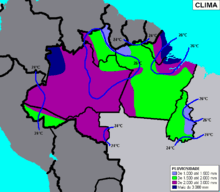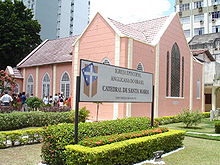- North Region, Brazil
-
North Region
Região Norte— Region — Location of North Region in Brazil Country  Brazil
BrazilStates AC, AP, AM, PA, RO, RR and TO Area – Region 3,853,327.2 km2 (1,487,777.9 sq mi) Area rank 1st Population (2005 census) – Region 14,726,059 – Estimate (2007) 15,022,060 – Rank 4th – Density 3.8/km2 (9.9/sq mi) – Density rank 5th – Urban 75.6% GDP – Year 2005/2006 estimate – Total R$120 billion (5th) – Per capita R$7,247 (4th) HDI – Year 2005–2006 – Category 0.764 – medium (4th) – Life expectancy 71 years (4th) – Infant mortality 25.8% (4th) – Literacy 88.7% (4th) Time zone BRT (UTC-04) – Summer (DST) BRST (UTC-03) The North Region of Brazil (Portuguese: Região Norte do Brasil) is the largest Region of Brazil, corresponding to 45.27% of the national territory. It is the least inhabited of the country, and contributes with a minor percentage in the national GDP and population. It is composed by the states of Acre, Amapá, Amazonas, Pará, Rondônia, Roraima and Tocantins.
Its demographic density is the lowest in Brazil considering all the regions of the country, with only 3.8 inhabitants per km2. Most of the population is centered in urban areas.
Belém International Airport and Manaus International Airport connects North region with many Brazilian cities and also operates some international flights.
The North is home to the Federal University of Amazonas and Federal University of Pará.
Contents
Geography
 Northern Vegetation. Green is Amazon Rainforest; Orange is Cerrado; Blue is coastal vegetation; Yellow is Hiliéan Fields.
Northern Vegetation. Green is Amazon Rainforest; Orange is Cerrado; Blue is coastal vegetation; Yellow is Hiliéan Fields.
The Amazon represents over half of the planet's remaining rainforests and comprises the largest and most species-rich tract of tropical rainforest in the world.
Wet tropical forests are the most species-rich biome, and tropical forests in the Americas are consistently more species rich than the wet forests in Africa and Asia.[1] As the largest tract of tropical rainforest in the Americas, the Amazonian rainforests have unparalleled biodiversity. More than 1/3 of all species in the world live in the Amazon Rainforest.[2]
The region is home to about 2.5 million insect species, tens of thousands of plants, and some 2000 birds and mammals species. To date, at least 40,000 plant species, 3,000 fish, 1,294 birds, 427 mammals, 428 amphibians, and 378 reptiles have been scientifically classified in the region.[3] Scientists have described between 96,660 and 128,843 invertebrate species in Brazil alone.[4]
The diversity of plant species is the highest on earth with some experts estimating that one square kilometre may contain over 75,000 types of trees and 150,000 species of higher plants. One square kilometre of Amazon rainforest can contain about 90,790 tonnes of living plants.[5] This constitutes the largest collection of living plants and animal species in the world. One in five of all the birds in the world live in the rainforests of the Amazon. To date, an estimated 438,000 species of plants of economic and social interest have been registered in the region with many more remaining to be discovered or catalogued.[6]
Demographics
City Population (2007) Manaus 1,612,475 Belém 1,408,847 Ananindeua 484,600 Porto Velho 426,558 Macapá 368,397 Rio Branco 288,614 Santarém 274,074 Ethnic groups
The population of northern Brazil is largely made up of Caboclos, descendants of Indians and Portuguese. The north of Brazil has received and continues to receive large migration of people from South and Southeast of the country. In the 20th century, the North also received great migration from the Northeast, who were working in the rubber plantations of Amazonas and Acre.
Skin color/Race (2006) White (European, Caucasian) 23.9% Black (African) 6.2% Brown (Multiracial) 69.2% Yellow (Asian) 0.49% Red (Amerindian) 0.7% Economy
The economy of the North Region is essentially based on the vegetal plantation and extraction, such as latex, açaí, woods and nuts; and mineral extraction of gold, precious stones, cassiterite and tin (metal); as well as mining exploitation, mainly iron, at Carajás Mountain Range (in the State of Pará) and manganese, at Navio Mountain Range (in the State of Amapá).
Curiosity
Vehicles: 1,746,501 (March/2007); Telephones: 1,805,000 (April/2007); Cities: 449 (2007).
Education
Portuguese language is the official national language, and thus the primary language taught in schools. But English and Spanish are part of the official high school curriculum.
Educational institutions
- Universidade Federal do Amazonas (UFAM);
- Universidade Federal do Pará (UFPA);
- Universidade Federal de Rondônia (UNIR);
- Universidade Federal do Acre (UFAC);
- Universidade Federal do Amapá (UNIFAP);
- Universidade Federal de Roraima (UFRR);
- Universidade Federal do Tocantins (UFT);
- and many others.
Transport
There are only a few highways in the North region. The most important ones are the Trans-Amazonian highway, running through Amazonas, Pará, Piauí, Maranhão, and the Rodovia Belém-Brasília, running through the Federal District, Goiás, Tocantins, Maranhão and Pará. Most of the transportation on the region is done by boat or airplane, mainly in the state of Amazonas. There are two major airports in the region: Belém International Airport, serving Belém, and Eduardo Gomes International Airport, serving Manaus.
References
- ^ Turner, I.M. 2001. The ecology of trees in the tropical rain forest. Cambridge University Press, Cambridge. ISBN 0-521-80183-4
- ^ "Amazon Rainforest, Amazon Plants, Amazon River Animals". World Wide Fund for Nature. http://www.worldwildlife.org/wildplaces/amazon/index.cfm. Retrieved 2007-11-26.
- ^ Da Silva et al. 2005. The Fate of the Amazonian Areas of Endemism. Conservation Biology 19 (3), 689-694
- ^ Lewinsohn, Thomas M.; Paulo Inácio Prado (June 2005). "How Many Species Are There in Brazil?". Conservation Biology 19 (3): 619–624. doi:10.1111/j.1523-1739.2005.00680.x.
- ^ Photos / Pictures of the Amazon Rainforest
- ^ The Amazon Rainforest
See also
- (English) Brazil
- (English) Brazilian Tourism Portal
 Brazil
BrazilHistory First inhabitants · Colonization · Empire · Old Republic · Vargas Era · Second Republic · Military rule · ContemporaryGeography Regions · States · Mesoregions · Microregions · Municipalities · Islands · Coastline · Climate · Environment · Extreme points · Protected areas · CapitalsGovernment Constitution · Federal government · President · National Congress · Foreign relations · Law · Law enforcement · MilitaryPolitics Economy Society Demographics · People · Languages · Religion · Immigration · Education · Health · Crime · Social issues · Largest cities · ApartheidCulture Demographics of Brazil Economic and social Apartheid · Attractions · Law · Crime · Education · GDP · Health · Human Development · Human Rights (LGBT Rights) · Immigration · Languages · People · Politics · Poverty · Races · Religions · Traditions · Wealth
Ethnic groups BrazilAfricaAmericasNorth AmericaCaribbeanHaitianSouth AmericaBy EthnicityBy Country
or RegionEasternSouthernEast IndianWesternEuropeBy EthnicityBy Country
or RegionNorthernWesternCentralSouthernBalkanEasternRegions and States of Brazil North Northeast Center-West Southeast South - Fernando de Noronha
- Rocas Atoll
- Saint Peter and Saint Paul
- Trindade and Martim Vaz
Categories:
Wikimedia Foundation. 2010.




